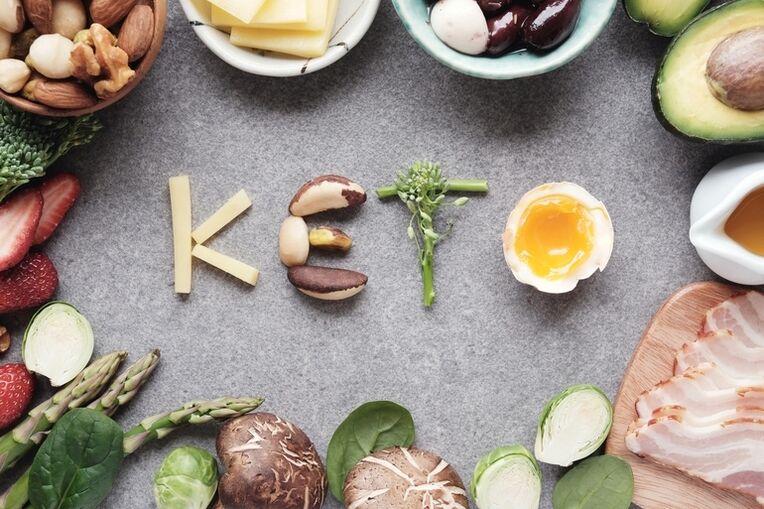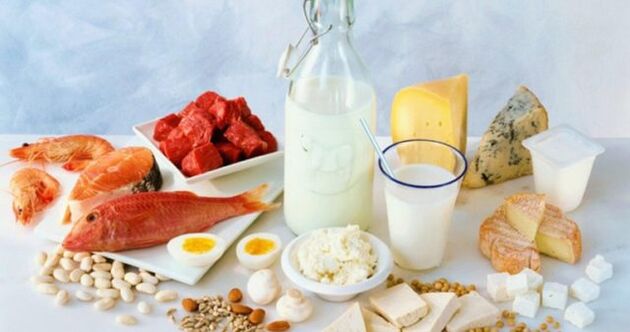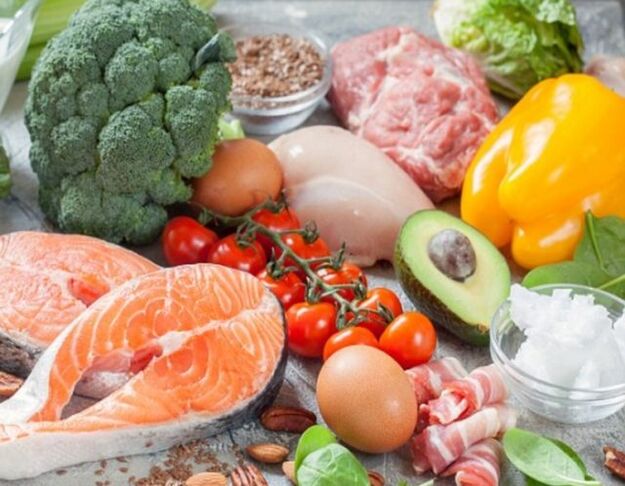The ketogenic diet was developed in 1921 to treat epilepsy. Then bodybuilders started using it to strengthen muscles. The use of fat for fuel is only possible with a reduced carbohydrate intake and a small percentage of protein - these are the principles of the keto diet.
What is the Keto Diet?
The ketogenic, ketogenic, or keto (keto) diet is a diet low in carbs, moderate in protein, and high in fat.
When carbohydrates are consumed, they lead to glucose formation and insulin production. Glucose is most readily consumed by the body for fuel. Insulin is needed to bring glucose into cells. In these cases, the fat remains unrecognized and just accumulates. But if you reduce your carbohydrate intake, the body is forced to enter a state of ketosis - a natural process when the body begins to use fat for fuel.

In the liver, in the absence of glucose, ketone bodies are formed from free fatty acids. Ketones or ketone bodies are molecules that carry energy for the body to function. The goal of keto is to become such a state.
There are 4 types, of which 3 are used by athletes and one is used by all other keto advocates:
- Standard: basic keto - %BJU ratio - 20: 75: 5.
- Purposeful: due to exercise, the amount of carbohydrates during exercise is increased.
- Cyclic: Higher carbohydrate intake, such as on weekends.
- High protein: instead of reduction, protein is increased by about 35%. The overall ratio of the BJU becomes - 35: 60: 5.
Approved products
The following products are allowed to be consumed:
- Any meat: veal, pork, poultry, etc. v. Do not remove fat from meat and chicken.
- In chickens, thighs and legs are preferred.
- Fish and seafood: any, but fatty fish is better - salmon, mackerel, sardines, anchovies, trout and herring, shrimp and squid.
- Eggs: in any form.
- Natural fats: lard and lard, buttermilk for frying, salted butter, coconut oil, butter, flaxseed and olive oil for salads.
- Nightshade vegetables: Kale, zucchini, eggplant, asparagus, olives, spinach, lettuce, greens and leafy greens.
- Mushrooms: any.
- High-fat dairy products only: full-fat milk (more than 3%), full-fat cream (20-40%), sour cream 25%, cottage cheese, Greek yogurt, full-fat hard cheese.
- Oilseeds and seeds: Macadamia, cashews, walnuts, sunflower seeds, pumpkin seeds, etc. v.
- Berries: in small quantities - raspberries, blackberries, blueberries.

Sometimes allowed:
- Alcohol: dry alcohol, unsweetened spirits (gin, rum, whiskey, vodka), unsweetened cocktails.
- Dark chocolate: very moderate, with more than 70% cocoa.
- Water, coffee with cream, tea and herbal teas of your choice.
- Chicken broth or chicken broth has at least 1g of sodium. When carbohydrates are reduced, glycogen is actively consumed. For its 1 g, 3 g of water is needed. With it, the amount of sodium the body needs is also gone. According to nutritionists, chicken broth is indispensable in this diet because it provides sodium for the body.
Prohibited products:
- Sweets - sugar, candies, cakes, cream, honey, maple syrup, agave.
- Sugary drinks - soft drinks, juices, coffee with a main ingredient of milk, beer, etc. v.
- Cereals, grains and rice are high in carbohydrates.
- Sweet fruits - bananas, apples, grapes, oranges, pears, mangoes, pineapples, etc. v.
- Beans are rich in carbohydrates.
- Potatoes are rich in starch.
- Store-bought sauces - ketchup and barbecue sauce.
- Margarine - complete lack of benefits.
- Artificial trans fats - sometimes worsen health.
Important! The more restrictive (less than 15 g of carbohydrates per day), the quicker a person will enter a state of ketosis.
Keto diet: menu
| Breakfast | Lunch | Dinner | afternoon tea | Dinner | |
|---|---|---|---|---|---|
| Second | Fried egg with asparagus and bacon, coffee with cream | high-fat cottage cheese; salad and chocolate | fried chicken breast in coconut oil, fried mushrooms, spinach, avocado and lime juice | boiled beef; some seeds and rosehip infusions | Tuna steak in olive oil, chili and garlic, fried broccoli and bean sprouts, grilled tomatoes |
| Tuesday | coffee with butter or buffalo milk, 3 boiled eggs | fatty cheese | beef, tomato, bacon fried in lettuce leaves; fish ball soup | cheese | low-carb chicken grandmasala (mixture of spices); salmon, cheese toast, tea |
| Wednesday | omelette with mushrooms and bell peppers in olive oil; ice cream with cream | cheese | bacon, avocado and feta salad; meat broth with herbs, chicken balls | 3 omelets; green tea, nuts. | fried pork chops with mayonnaise and onions; pureed green apple |
| Thursday | minced beef, toast | turkey, green tea. | minced beef broth; meatballs from field perch; sauteed cabbage and broccoli with eggs in the form of a salad, unsweetened gravy. | rosehip broth, chicken breast | avocado and shrimp with creamy mayonnaise and chili sauce |
| Friday | bacon and cauliflower scrambled eggs | cheese, vegetable salad, dog tree broth | Fish broth with meatballs, chicken soup, quince broth. | zucchini, vegetable salad | noodles with turkey, tomato, mushroom and parmesan sauce |
| Saturday | pizza made from cauliflower | fatty cheese and green tea | Minced beef, toast, butter coffee | Salmon salad with tomatoes and cranberries | Low carb beef with chili sauce and garlic |
| Sunday | bacon and salad tarts | 3 hard-boiled eggs, crackers, unsweetened dough | red fish, cheese toast | Chicken caesar salad with parmesan cheese | beef pate, kefir |
Who is forbidden to diet like that?
The keto diet is contraindicated for:
- Diabetes
- hypertension;
- hypercholesterolemia;
- kidney and gastrointestinal diseases;
- decompensation of cardiac activity;
- during pregnancy and lactation.

Benefits and harms of the Keto diet
Benefits of the Diet:
- effectively solve the problem of weight loss, muscle gain, body drying;
- regulate blood sugar;
- Helps control type 2 diabetes
- improve cognitive ability;
- normalize cholesterol and blood pressure;
- clean acne-prone skin;
- helping epilepsy patients reduce the number of times of taking anticonvulsant drugs;
- useful in Alzheimer's disease and Parkinson's disease;
- financially inexpensive;
- The dishes are not difficult to prepare.
Defect:
- low carb, unbalanced
- not visible to everyone;
- reduce working capacity and memory.
The opinion of nutritionists about the Keto diet
The highlight of the keto diet is foods high in protein and fat, with extremely low fiber content. This causes bloating and heaviness in the abdomen and constipation. In addition, the intestine is also invaded by pathogenic microorganisms, ending in dysbacteriosis. Immunity is reduced. To avoid such problems, dietary fiber should be consumed at least to a minimum - cabbage, apples, sour grapes.
A big minus is the lack of carbohydrates, the body can react to this with an inadequate response.
If physical activity is higher than the body's capacity, this can cause hypoglycemia in the form of weakness, pressure drop, dizziness, nausea, possible fainting and collapse. To prevent it, it is better to use juices and semi-sweet fruits with snacks, and when the first signs of hypoglycemia appear, drink tea with honey.

Glucose deficiency reduces brain function. The cognitive components - attention, concentration, memory - are particularly affected. Once they reach the ketosis phase, they will partially recover, but the levels will still fall short of the previous norm. Therefore, when taking exams, doing stressful mental work, it is better not to apply this diet.
The ketogenic diet can lead to kidney stones, dehydration, increased blood cholesterol levels, constipation, and gout attacks. The essential minerals and vitamins provided by keto are deficient, so a multivitamin supplement is required.
Keto, of course, will improve the body and move the metabolism away from basal and weight loss, but the transition to such a particular diet is quite difficult and requires the advice of a doctor. . The keto diet is not for everyone. Only a doctor, after examining the current condition, can say whether it is permissible to start a diet.
































